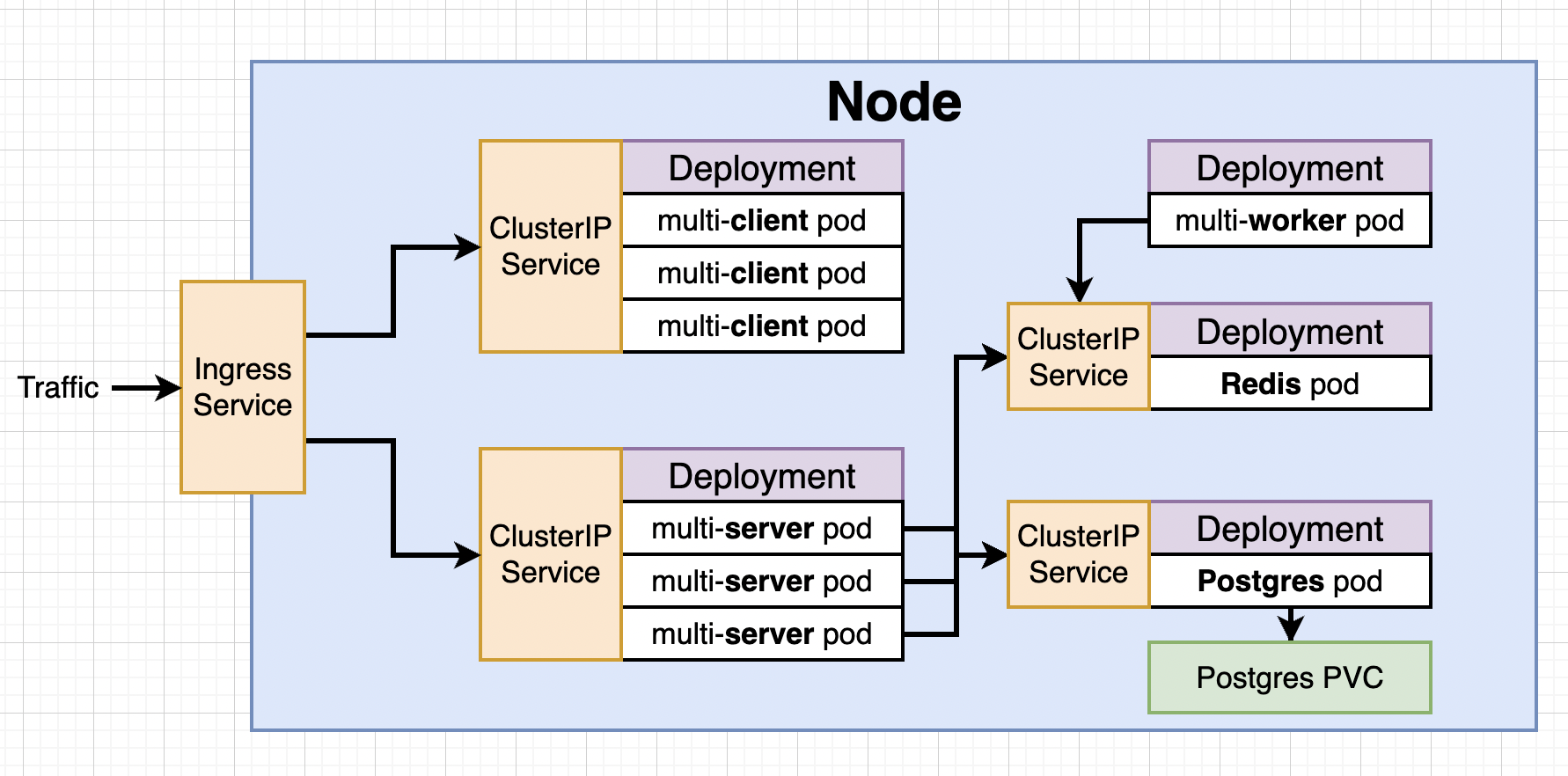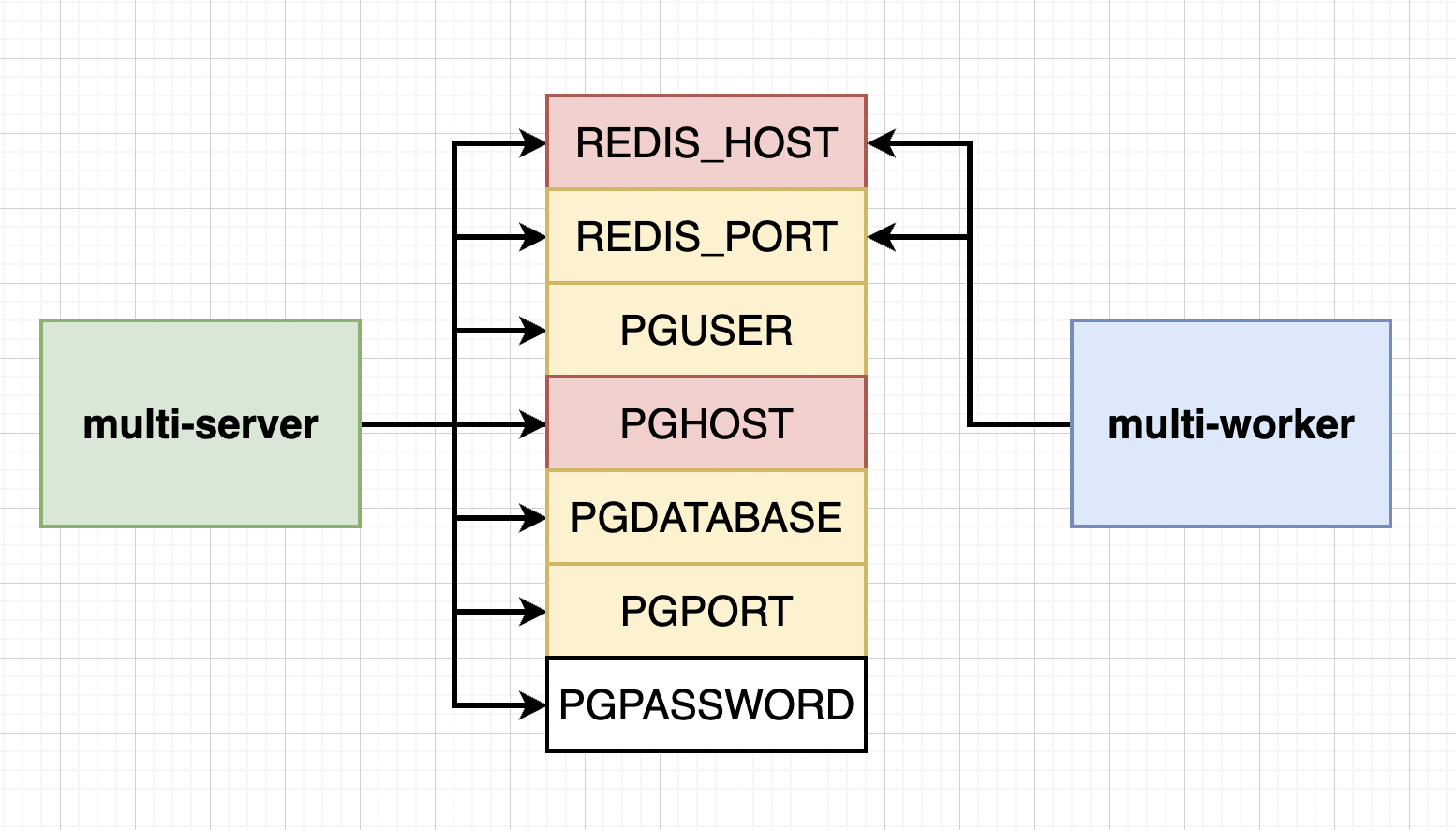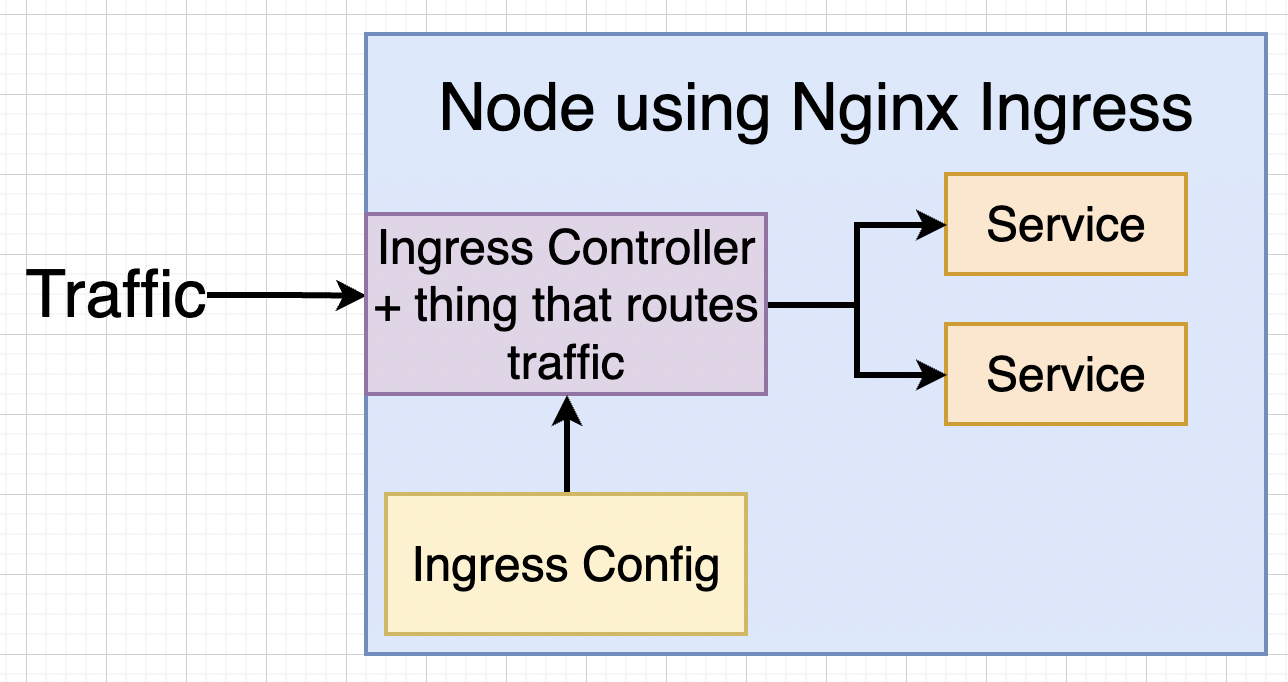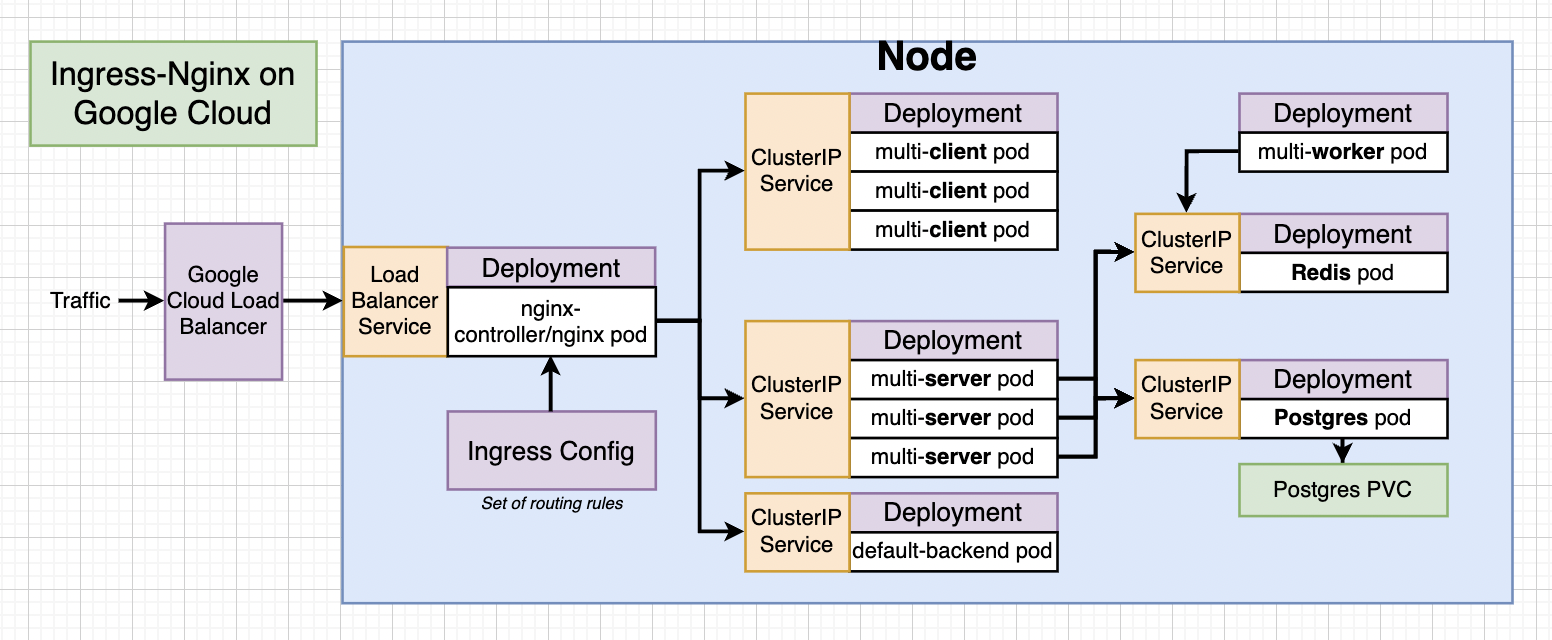Notes : Kubernetes¶
Section 14 : A Multi-Container App with Kubernetes¶
Path to Production¶
We will first develop everything in single Node locally and when we deploy it off to some service like AWS we will have option of multiple Nodes.
So we will have a lots of config files for pods and services :)
Clone the following repository Link , checkout the branch: checkpoint_k8s and execute:
docker compose up --build
Recreating the Deployment¶
Remove the nginx folder since we will be using Ingress Service. Remove the aws deployment file, travis.yaml, and Docker compose files. Now directory should have only 3 folders : client, server, worker.
We we be recreating everything using Kubernetes. We will need to create 9-10 config files. Make a new directory k8s inside complex.
Create a file client-deployment.yaml
apiVersion: apps/v1
kind: Deployment
metadata:
name: client-deployment
spec:
replicas: 3
selector:
matchLabels:
component: web
template:
metadata:
labels:
component: web
spec:
containers:
- name: client
image: stephengrider/multi-client
ports:
- containerPort: 3000
NodePort vs Cluster IP¶
NodePort: Exposes a set of pods to outside world (only good for dev purposes).
Cluster IP: Exposes a set of pods to other objects in the cluster. We use Ingress with it to allow external access.
Create a new file, client-cluster-ip-service.yaml
apiVersion: v1
kind: Service
metadata:
name: client-cluster-ip-service
spec:
type: ClusterIP
selector:
component: web
ports:
- port: 3000
targetPort: 3000
To apply above two file inside of k8s directory.
kubectl apply -f k8s
Express API Deployment Config¶
We will create 2 more files with almost similar config files.
Create a new file server-deployment.yaml
apiVersion: apps/v1
kind: Deployment
metadata:
name: server-deployment
spec:
replicas: 3
selector:
matchLabels:
component: server
template:
metadata:
labels:
component: server
spec:
containers:
- name: server
image: stephengrider/multi-server
ports:
- containerPort: 5000
Note : Remember multi-server expects a bunch of environment variables.
Cluster IP for Express API
Create a new file server-cluster-ip-service.yaml
apiVersion: v1
kind: Service
metadata:
name: server-cluster-ip-service
spec:
type: ClusterIP
selector:
component: server
ports:
- port: 5000
targetPort: 5000
Combining Config into Single Files¶
We said we will have 9-10 config files, you can organize multiple config files into a single file.
Each of config should be separated by three dashes
config_file-1
---
config_file-2
Worker Deployment¶
Create a file named worker-deployment.yaml
apiVersion: apps/v1
kind: Deployment
metadata:
name: worker-deployment
spec:
replicas: 1
selector:
matchLabels:
component: worker
template:
metadata:
labels:
component: worker
spec:
containers:
- name: worker
image: stephengrider/multi-worker
env:
- name: REDIS_HOST
value: redis-cluster-ip-service
- name: REDIS_PORT
value: 6379
Now remember we will eventually need more replicas since worker is actually the part of application that handles most of calculation.
Also note no port and ClusterIP file needed since it connects to other and does the work.
Creating and Applying Redis config¶
Create a file redis-deployment
apiVersion: apps/v1
kind: Deployment
metadata:
name: redis-deployment
spec:
replicas: 1
selector:
matchLabels:
component: redis
template:
metadata:
labels:
component: redis
spec:
containers:
- name: redis
image: redis
ports:
- containerPort: 6379
Create a file redis-cluster-ip-service.yaml
apiVersion: v1
kind: Service
metadata:
name: redis-cluster-ip-service
spec:
type: ClusterIP
selector:
component: redis
ports:
- port: 6379
targetPort: 6379
PostgreSQL config¶
Create a file postgresql-deployment.yaml
apiVersion: apps/v1
kind: Deployment
metadata:
name: postgres-deployment
spec:
replicas: 1
selector:
matchLabels:
component: postgres
template:
metadata:
labels:
component: postgres
spec:
containers:
- name: postgres
image: postgres
ports:
- containerPort: 5432
The Need for Volumes with Databases¶
We can certainly create database and storage inside containers/pods. But wait what if there is some error in pod what does Master does ? :) creates new pods and data is lost.
We use PVC (Persistent Volume Claim) as separate storage solution i.e. Volumes which provide consistent data storage solution.
As indicated earlier we can certainly have more than one replicas of Postgres but if there are 2 replicas of postgres and they are sharing one filesystem for storage and they are not aware of each other then its recipe for disaster.
Volume in Docker was related to mechanism that allows a container to access a filesystem outside itself. Volume in Kubernetes is an object that allows containers to store data at the pod level.
Note in Kubernetes there is PVC, Persistent Volume, Volume (we don’t want it for data that needs to persist)(Also not same as volume in dockers). Be careful what documentation refers to.
If we create a Volume (we should not) then there are containers and volumes within pod, and if containers did crash volume will persist but what if entire pod gets deleted then entire volume and containers will be gone that is why we use Persistent Volume. Even if pod now gets deleted there will be no effect to Persistent Volume.
PV vs PVC¶
PVC is just a claim its not an actual storage, instead it advertises the options available to you. There are 2 ways to provision your Volumes
- Statically provisioned Volume
- Dynamically provisioned Volume
Claim Config Files¶
Create a file name database-persistent-volume-claim.yaml
apiVersion: v1
kind: PersistentVolumeClaim
metadata:
name: database-persistent-volume-claim
spec:
accessModes:
- ReadWriteOnce
resources:
requests:
storage: 2Gi
Note Volume Claim is not actual storage ! There are 3 types of access modes
- ReadWriteOnce : Can be used by a single node
- ReadOnlyMany : Multiple nodes can read from this
- ReadWriteMany : Can be read and written to by many nodes.
Where does Kubernetes Allocate Persistent Volumes ?¶
When you ask Kubernetes for storage in local development context then it will take a slice of your hard-drive otherwise it have PlugIn support for many services out there for example, Google Cloud Persistent Data, Azure Files, Azure Disk, AWS Block Store, etc.
Visit this Page for more details.
Add following property in spec of Kubernetes config file of postgres-deployment.yaml
spec:
volumes:
- name: postgres-storage
persistentVolumeClaim:
claimName: postgres-persistent-volume-claim
containers:
- name: postgres
image: postgres
ports:
- containerPort: 5432
volumeMounts:
- name: postgres-storage
mountPath: /var/lib/postgresql/data
subPath: postgres
subPath is specific to postgres, it just stores data in a folder name postgresql.
Defining Environment Variables¶
Here Red Variables are the ones that keep changing and Yellow one are consistent. To connect to cluster just provide the name of the Cluster-IP-service you want to connect to it.
Add following to worker-deployment.yaml env right after image tag
image:
env:
- name: REDIS_HOST
value: redis-cluster-ip-service
- name: REDIS_PORT
value: 6379
and to server-deployment.yaml
ports:
env:
- name: REDIS_HOST
value: redis-cluster-ip-service
- name: REDIS_PORT
value: 6379
- name: PGUSER
value: postgres
- name: PGHOST
value: postgres-cluster-ip-servicec
- name: PGPORT
value: 5432
- name: PGDATABASE
value: postgres
Creating Encoded Secret¶
PGPASSWORD should not be plain text. We will use new object in Kubernetes that is Secrets which securely stores information in the cluster, such as database password.
To create a secret we use following command
kubectl create secret generic <secret_name> --from-literal key=value
Example : Run the following command
kubectl create secret generic pgpassword --from-literal PGPASSWORD=12345asdf
To add this to server-deployment.yaml
- name: PGPASSWORD
valueFrom:
secretKeyRef:
name: pgpassword
key: PGPASSWORD
and for postgres-deployment.yaml
image:
env:
- name: POSTGRES_PASSWORD
valueFrom:
secretKeyRef:
name: pgpassword
key: PGPASSWORD
NOTE : In recent documentation its necessary to name the variable POSTGRES_PASSWORD in postgresql-deployment.yaml
Note : you always provide Environmental variable in strings i.e. pass ports as string. If you get a not able to convert error its probably because you passed the ports as numbers.
All file should now match the repository at this point link
Section 15: Handling Traffic with Ingress Controllers¶
Load Balancer Services¶
LoadBalancer : Legacy way of getting network traffic into a cluster.
Load Balancer won’t give access to multiple nodes that is the reason we are not using it. Traditionally load balancers were provided by the cloud providers ( still being provided) but some people thing these loadbalancers are deprecated, yet kubernetes official documentaion doesn’t provide any such indication.
A Quick Note on Ingress¶
In Kubernetes there are multiple implementations of Ingress and we are gonna use Ngnix Ingress.
- We are using nginx-ingress, a community led project.
- We are not using kubernetes-ingress, a project led by nginx company.
NOTE: Setup of ingress-ngnix changes depending on your environment(local, GC, AWS, Azure). We are going to set up ingress-nginx on local and GC.
Behind the scenes of Ingress¶
In Kubernetes world anything that contstantly work to reach some desired state is called as Controller. For examples, our deployments was constantly making sure pods run, they are also a Controller.
We are going write a config file and the kubectl will generate Ingress Controller which will handle traffic for Nodes.
For Google Cloud Setup of Ingress-Nginx
Behind the scenes on Google Cloud still loadBalancer is used.
To read more about Ingress Nginx Refer Here
After this point instruction won’t work on latest M1 chip, use other drivers rather than docker desktop. Still you can try port forwarding , read more on the website.
Setting up Ingress Locally with Minikube¶
Navigate to https://kubernetes.github.io/ingress-ngnix then to Deployment -> Generic Deployments and follow instructions.
Install a ingress addon using kubectl
Creating the Ingress Configuration¶
Create a file named ingress-service.yaml
apiVersion: networking.k8s.io/v1
# UPDATE API
kind: Ingress
metadata:
name: ingress-service
annotations:
kubernetes.io/ingress.class: 'nginx'
nginx.ingress.kubernetes.io/use-regex: 'true'
# ADD ANNOTATION
nginx.ingress.kubernetes.io/rewrite-target: /$1
# UPDATE ANNOTATION
spec:
rules:
- http:
paths:
- path: /?(.*)
# UPDATE PATH
pathType: Prefix
# ADD PATHTYPE
backend:
service:
# UPDATE SERVICE FIELDS
name: client-cluster-ip-service
port:
number: 3000
- path: /api/?(.*)
# UPDATE PATH
pathType: Prefix
# ADD PATHTYPE
backend:
service:
# UPDATE SERVICE FIELDS
name: server-cluster-ip-service
port:
number: 5000




